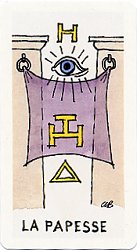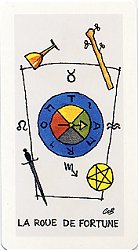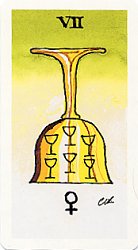 Square and Compasses Tarot: A Tarot deck for all Freemasons by Colin
Browne
Square and Compasses Tarot: A Tarot deck for all Freemasons by Colin
BrowneReview by Diane Wilkes
 Square and Compasses Tarot: A Tarot deck for all Freemasons by Colin
Browne
Square and Compasses Tarot: A Tarot deck for all Freemasons by Colin
Browne
Review by Diane Wilkes
The square and compasses is the most widely known emblem of the Freemasons; when you see it on a building, you know that this is a temple or meeting place for them, so it makes sense that Browne has entitled his tarot deck for Freemasons thus. As a female, I am prohibited from being a Freemason. However, in my deathless desire to be a responsible reviewer, I did do some research on the subject and was in contact with the deck creator, Colin Browne (aka Bro. P.C. Browne, P.Z.), as I worked with this deck.
The cards did not arrive in order in the box--I don't think numbering them is an initiatory practice, but one never knows. The Major Arcana are not numbered and Browne has used traditional French titles. The Minors are assigned Roman numerals. Moreover, in the Little White Booklet (LWB), the artist offers his own numbering format in accordance with his view of the Masonic path of development, which he lists as "The Import of the Major Arcana." These paths correspond with his version of the paths on the Tree of Life. They are as follows:
| Path 32 | Le Monde - Earthly matters | (The Candidate) |
| Path 30 | Le Fou - Innocence | (The Entered Apprentice) |
| Path 27 | Le Pendu - Uncertainty | (The Fellow of Craft) |
| Path 24 | La Mort - Change and Transition | (The Master Mason) |
| Path 22 | Le Soleil - Profit and Pleasure | (The Junior Warden) |
| Path 19 | Le Bateleur - Magick and Mastership | (The Worshipful Master) |
| Path 14 | L'Empereur - Alpha male authority on secular matters | (Zerababul, Prince of the People) |
| Path 11 | La Papesse - Alpha female religious authority | (Haggi the prophet) |
| Path 31 | La Diable - Punishment and Remorse | |
| Path 29 | Les Amoureux - Love and Procreation | |
| Path 28 | La Roue de Fortune - Luck and Life Goals | (The Mark Master Mason) |
| Path 26 | La Temperance - Moderation and The Magic Arts | |
| Path 25 | Le Feu du Ciel - Caution | |
| Path 23 | La Force - Decisions | |
| Path 21 | Le Chariot - Dynamism and Creativity | |
| Path 20 | La Lune - Time, Fluidity, Femininity and Equality | (The Senior Warden) |
| Path 18 | La Justice - Karma and Justice | |
| Path 17 | L'Imperatrice - Fertility, Plenty, Pregnancy and Rebirth | (The 2nd Degree Tracing Board*) |
| Path 16 | L'Ermite - Experience | (The Past Master) |
| Path 15 | Les Etoiles - Meditation, Astrology and Healing | (The 1st Degree Tracing Board) |
| Path 13 | Le Judgement - Transformation | (The 3rd Degree Tracing Board) |
| Path 12 | Le Pape - Alpha Male Religious Authority | (Joshua, Son of Jehosadek) |
The deck is executed in a naїve art style, though the subject matter would indicate a more precise and stylized approach. Yet Browne states in the Little White Book that he chose this "distinctly hand-crafted" style because "Freemasonry is all about 'craft'." Fine art and craft are not mutually exclusive, I don't think. The Hermetic Tarot comes to mind as a counterpoint.
While the Compasses and Square Tarot is possibly ideal for Freemasons, many
of you reading this review want to know what can tarotists who are not
Freemasons derive from this deck? Well, the kabbalists (and qabalists) might
embrace the deck, since Freemasonry is based on kabbalistic principles (The
Great Light). For example, the suits correspond to Atziluth, Briah,
Yetzirah, and Assiah. Unfortunately, Browne refers to them as suites, which
always makes me think of the Marriott Courtyard, and the Little White Book (LWB)
indicates that it is not the art that reflects the four worlds, but Browne's
state of mind as he created the "suites." That's all very well for a personal
project, but isn't all that illuminating for the average deck purchaser.
Freemasons, however, might not need additional artistic illumination.
the suits correspond to Atziluth, Briah,
Yetzirah, and Assiah. Unfortunately, Browne refers to them as suites, which
always makes me think of the Marriott Courtyard, and the Little White Book (LWB)
indicates that it is not the art that reflects the four worlds, but Browne's
state of mind as he created the "suites." That's all very well for a personal
project, but isn't all that illuminating for the average deck purchaser.
Freemasons, however, might not need additional artistic illumination.
Even the box containing the cards offers terminology unfamiliar to the layperson. On one side of the box reads: A 78 card tarot deck of The Masonic Craft, ITNOTGAOTU. For the record, those letters stand for "In The Name Of The Great Architect Of The Universe," but as soon as I spied them, I got kind of cranky. I don't like to see words with which I am unfamiliar adorning my tarot deck boxes. Your mileage, as they say, may vary.
The Fool, however, is eminently
recognizable, and as you go through the cards, with the High Priestess' veil and
columns, the four "suite" emblems cornering the Wheel, and
The Moon's baying beasts, you realize the
Majors are eminently readable and filled with mystical elements and symbols.
While the art doesn't take one's breath
 away, it has a winning
sincerity and wholeness of purpose.
away, it has a winning
sincerity and wholeness of purpose.
The Minors are rather spartan, yet convey familiar messages. The Seven of Cups includes the planetary ruler (Venus) as well as the dissolution the card often indicates. The Two of Swords is given the title "Peace Restored," but displays the glyphs of Saturn and Mercury, which is not a traditional Golden Dawn assignment.
The Court Cards are probably the least artistically successful ones in the deck, and were completed two years after the others. Browne sees these cards as "being more specifically related to divination." They are categorized as King-Knight, Queen, Prince, and Princess, but the cards themselves are delineated oddly. The Prince and Princess simply are marked P and have a Venus glyph after the P for Princess and a glyph of Mars after the P for Prince. The Queen is marked "Q" and the King-Knight, "Kt." They only show the emblem of the suit--no human (or other) bodies.
The cards are sturdy and slightly smaller than standard. The backs are elegant--square and compasses in black and white--and reversible. Because the Majors are unnumbered and, in the LWB, ordered by path, one is unsure as to Browne's intent in numbering Strength as VIII or XI.
Browne uses this deck for personal meditation and magickal ritual. In many ways, this deck reminds me of a less-complex (and more aesthetically pleasing) Tarot of Ceremonial Magick, and Duquette has written about his experiences as a Freemason and the mysteries of the Rosicrucian Cross in his book on the Thoth deck. The Golden Dawn corpus of material is built on Freemasonry as well as Kabbalah, and has influenced the Rider-Waite-Smith and Thoth Tarots, among others. So even though the style of this deck is not one that often appeals to me, I find the Compasses and Square Tarot rather engaging, particularly as a deck to work with with regarding the qabala and the Tree of Life.
I recommend it to those who share those interests, as well as to every Freemason who is reading this page.
Some additional information re: abbreviations in the LWB, with thanks to Colin Browne:
| Yes | No | |
| 78 cards | X | |
| Reversible Backs | X | |
| Strength VIII, Justice XI N/A | ||
| Color Images | X | |
| Standard (RWS) Titles of the Major Arcana | X | |
| Traditional (RWS) Suits (Rods/Wands, Cups/Chalices, Swords, Pentacles/Disks/Coins) | X | |
| Traditional (RWS) Golden Dawn Suit-Element Attributions | X | |
| Standard dimensions (approx. 4 3/8" X 2 3/8") | X | |
| Smaller than standard | X | |
| Larger than standard | X | |
* A tracing board is an allegorical painting akin to a tarot card, according to Browne
You can see more cards from this deck here.
If you are interested in purchasing this deck, click here.
Images © 2003 Colin Browne
Review and page © 2004 Diane Wilkes